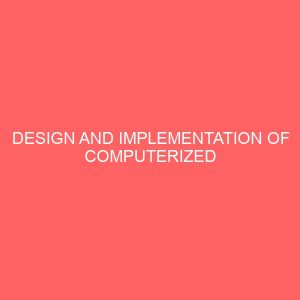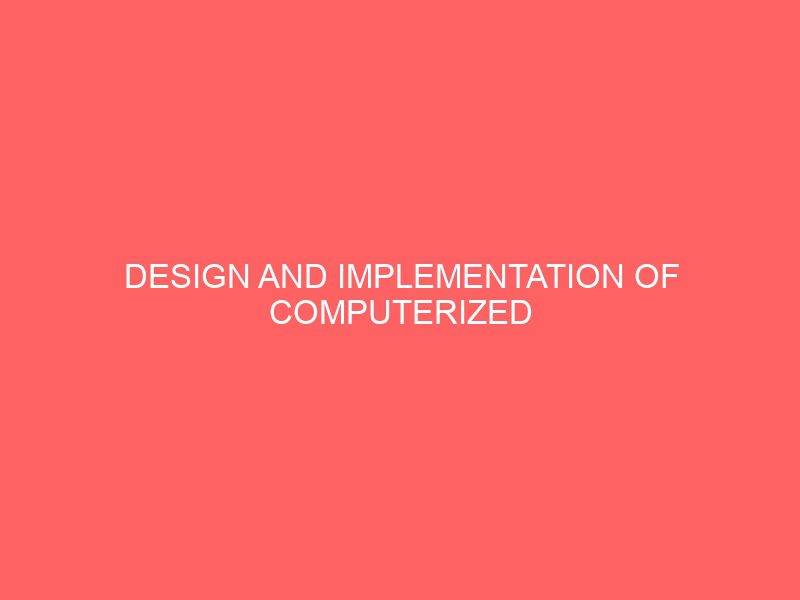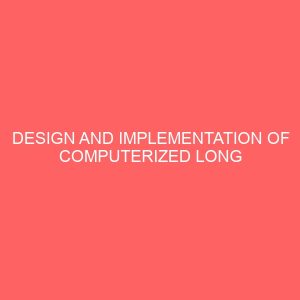Description
CHAPTER ONE
INTRODUCTION
1.1 Background of the Study
Menu plays an integral role in the restaurant industries as it serves as a communication tool between the kitchen and the customer. It presents the available foods and drinks within the restaurant and their respective prices to the customers.
Though menu is found in most of the restaurant worldwide but the mode, type and method differs from restaurant to restaurant base on location, type of the targeted customers and the standard of the restaurant. These include the human menu; which makes use of verbal communication between the customer and the waiter in which the waiter verbally tells the customer the available food and the customer make his choice verbally also without any documentation. The paper menu; this type of menu, uses the pen, the paper printed with the available food and the customer make use of the pen to make his or her choice. Lastly the digital/electronic menu; this is the most accurate and efficient type which deploys information and communication technology facilities to perform its functions.
Businesses in hospitality industry based on food services have grown significantly worldwide. In the last few years where many restaurants have opted to offering various types of menus for the customer, this has increased the competition in the hospitality industry. The restaurants have to provide the best services and maintain relationships with their customer in order to survive in this competition.
One way that restaurateurs have chosen to address this issue is through the introduction of technology in the industry. The use of technology has become very diverse within the industry and ranges from minimal to extensive use and has assisted in altering the way restaurateurs conduct business (Huber, Hancer & George, 2010).
With the upsurge in Information and Communication Technology, many industries use telecommunication network as a medium of exchanging information. To overcome the problems faced by the restaurants, an application could be designed and implemented in a medium or large scale restaurant. The application is installed on each of the devices on the restaurant table. The customer can select the food from the menu application installed on the device provided on the table and then the order from the customer can be sent via the network to the kitchen.
1.2 Statement of the Problem
Though menu plays a vital role in the restaurant industry as it is seen as the key disseminator of information and provides users with detailed descriptions that serve as a guide in the ordering process. In Nigeria, especially in Bauchi of Bauchi state to be specific, almost all the restaurant within the city, still make use of the paper base menu which is error prone and slow in performance which has serious effect on customer satisfaction. Within this locality, little is known about the customer and restaurant manager views on computerized restaurant menu, and the effect of its information, the service of waiting staffs and the new technology on customer satisfaction.
1.3 Objective of the Study
The general objective of this study is to design and implement a computerized Restaurant menu and the specific objectives are:
- To analyze the requirement of the proposed system.
- To design and develop computerized restaurant menu system.
- To test and implement the computerized restaurant menu system.
- Research question
To fill the knowledge gap on this topic (design and implementation of computerized restaurant menu system), this study seeks to investigate the following questions.
Q1. What are the views of the customers on computerized restaurant menu system?
Q2. What is the view of the restaurant management on computerized menu system?
Q3. Does the information on the menu, the waiting staff and the innovative technology on menu displaying devices affect customer satisfaction?
- Significance of the Study
At the end of this study, computerized restaurant menu system will be design and implemented, the stance of the customer on the new system, will be determined and the effect of information on the menu, the waiting staff and the innovative menu technology on displaying devices, on customer satisfaction will be established and it conclusion shall be beneficial to the restaurateur and the scholars in the field of hotel and restaurant management.
- Assumption and Delimitation
In carrying out this research, the following assumptions were made: That the technology innovation in the menu system will have positive impact in the restaurant in terms of the job efficiency, the Information available on the innovated menu has a positive effect on customer satisfaction., the Service provided with by the computerized menu, will give the restaurant customers sense of participation in the food ordering procedure.
The delimitations of this study are: the menu designed does not include functionalities that allow the customers to create an account and this is due to the fact that the menu was meant to be used only from the table within the restaurants. The menu server application is hosted on the local server and this is due to lack of finance needed to host the application online.
- Scope of the Study
This study focuses on the restaurants within the Bauchi of Bauchi state Nigeria. It focuses on what the computerized menu system does, the view of the restaurant customers about the menu, the effect of the information provided by the menu, the technology innovation on menu displaying devices and the services of the waiting staffs on customer satisfaction.
- Limitation of the Study
Due to time and financial constraints, the program is not without some limitations which include: The client application is not flexible enough in the sense that its content cannot be automatically updated from the server.
The server applications still rely on human waiter to relay reply to the customer because the server cannot send reply to a specific client over the network.
The menu system is never partition into section to indicate various meals suitable for a particular time of the day.
Both the network connectivity and database system depend on local hosting.
- Definition of Term
Automation: is the creation and application of technology to perform, monitor and control activities originally meant to be carryout by human.
Client Application: this is a program design to perform a particular function by sending the request to another program known as the server to execute, request and then retrieve the output from the server before relaying it to the user
Client – Server Application: Describes an application architecture in which the client requests an action or service from the provider of the service, the server.
Computerized menu system: This is a computer program specially written in such a way that it can display food and drinks option available in a restaurant and convey the customer choice of food to the kitchen.
Restaurant: Is a business establishment, with the main aim of preparing food and drinks for customer in an exchange for money.
Restaurateur: Describe anyone who owns a restaurant
Server Application: Is an application that waits for request from other applications and respond to them, thus providing a “service” upon their request.
Waiter: Is a man whose job is to serve customer in a restaurant.
Waitress: Is a woman whose job is to serve customers at their tables in a restaurant.








Reviews
There are no reviews yet.